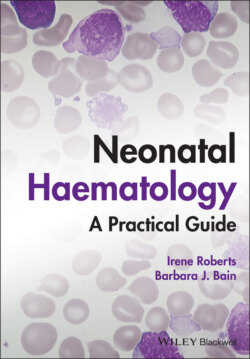Читать книгу Neonatal Haematology - Barbara J. Bain, Irene Roberts - Страница 38
Neonatal platelet function
ОглавлениеStudies of neonatal platelet function in vitro have consistently shown hyporeactivity of neonatal compared with adult platelets to a wide range of platelet agonists, including adenosine diphosphate (ADP), thrombin and thromboxane and especially so to collagen and adrenaline (epinephrine).132,149 In keeping with this, the number of α‐adrenergic receptors on neonatal platelets has been found to be 50% lower than on adult platelets.150,151 By contrast, expression of the main platelet adhesion receptors appears to be similar in neonatal and adult platelets, with the exception of glycoprotein (Gp) IIb/IIIa, which is expressed at lower levels in neonatal platelets.152 Importantly, follow‐up studies have shown that previously impaired platelet responses in neonates are similar to adult responses within 2 weeks of birth.152,153 Another point of note is that most studies of neonatal platelet function have been carried out on cord blood platelet‐rich plasma. However, more recent studies on whole blood have shown that healthy neonates have robust primary haemostasis overall, despite apparently hypofunctional platelets as assessed using standard techniques in platelet‐rich plasma. This may, at least in part, be due to the higher haematocrit and higher levels of von Willebrand factor in neonates. In addition, measures of in vitro platelet activation and aggregation in cord blood do not match those obtained when studying peripheral blood.154 These observations have led some investigators to conclude that the function of neonatal platelets should not be viewed as impaired but, instead, that neonatal platelets function as a component of a generally well‐balanced neonatal haemostatic system.149
